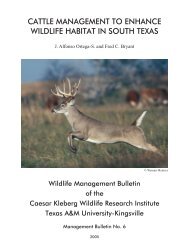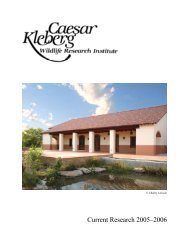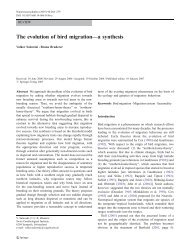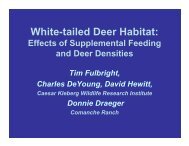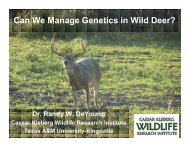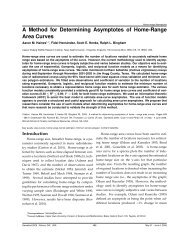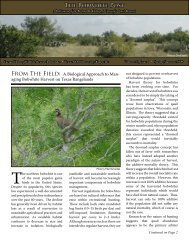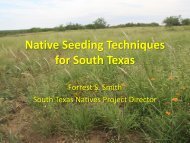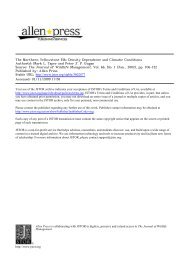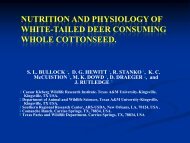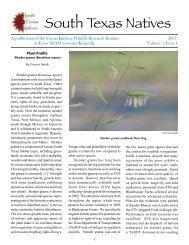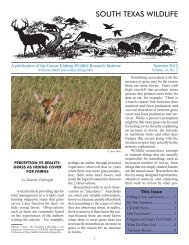Feeding-Up Fawns - Caesar Kleberg Wildlife Research Institute ...
Feeding-Up Fawns - Caesar Kleberg Wildlife Research Institute ...
Feeding-Up Fawns - Caesar Kleberg Wildlife Research Institute ...
You also want an ePaper? Increase the reach of your titles
YUMPU automatically turns print PDFs into web optimized ePapers that Google loves.
<strong>Feeding</strong>‐<strong>Up</strong> <strong>Fawns</strong>: Pen designs toimprove fawn accessMatthew Moore –Faith Ranch <strong>Wildlife</strong> Biologist
Why are feed pens necessary?• Reduce feed consumption by non‐target animals– Cattle– Feral hogs– Javelina (Collared Peccary)
Why is it important to allow fawns accessto feed as early as possible?• Improve Nutrition– Supplement dietduring weaning– Train fawns to utilizethe resource– Silver Spoon effect– Vogt effect
Why is it important to allow fawns accessto feed as early as possible?• Increase Survival– Orphaned fawns• Adult Doe Harvest• DMP pen stocking
Improved Nutrition• Fawn growth from Comanche‐Faithenclosure capturesG row th Rate (lbs/day)0.40.30.20.10.0Faw n Grow th Rate5 lbsFedUnf ed10 lbsFemaleMaleComanche‐Faith Project; Unpublished Data
Balke and Hewitt Study Design• 3 Pen Designs to determine fawn access– Net wire fence 36” high– Net wire fence 36” high with 8” slots cut on 2 sides– No fence
Results of Balke and Hewitt Study
Faith Ranch Fall 2011 Camera Study Design• 3 feed pen designs– No fence– Round pen with 34” galvanized hog panel– Round pen with 50% of panels lowered to a height of 28”
Faith Ranch 2011 Fall Camera Study Design• Cameras collected data for 1 week intervals eachmonth from August until January at each of the 3feed pen designs• Recorded the number of Does and <strong>Fawns</strong> present
Results of Faith Ranch Fall 2011 study
Results of Faith Ranch Fall 2011 Study
Does Fence Design Influence Fawn Visitation Rates at Supplemental Feed Stations?Chase R. Currie and David G. Hewitt<strong>Caesar</strong> <strong>Kleberg</strong> <strong>Wildlife</strong> <strong>Research</strong> <strong>Institute</strong>, Texas A&M University-Kingsville, Kingsville, Texas 78363, USAINTRODUCTIONRESULTSVisitation rates of white‐tailed deer at resource sites (i.e. supplemental feed stations, cornfeeders, or water stations) are influenced by social interactions between sexes and among age classes. Between sexes,males are generally dominate over females among all age classes. However, previous research has indicated the socialrelationship between adult females and yearling males was equal in most seasons, but during spring yearlings maleswere dominant (Donohue et al. 2011). Among age classes within sexes, older animals are typically dominate overyounger animals.Fawn visitation is influenced by a variety of factors, many of which stem from socialinteractions which were discussed above. Furthermore, feeder pen design may influence fawn visitation rates during thefirst 6 months of life because of accessibility, or lack thereof by fawns. The standard fence panel used for exclusion ofnon‐target animals has a minimum fence height of 34 inches if placed on a level surface. Recent studies have indicatedthis type of panel may be to tall for fawns to jump; therefore, limiting access to supplemental feed early in life(VanBogelen et al. 2010). We hypothesize fawn visitation rates at supplemental feed sites will be influenced by feederpen design, and higher visitation rates will occur at feeder pens with lower fence heights.OBJECTIVEOur objective was to assess patterns of white-tailed deer fawn visitation rates atthree feeder pen designs using Fawn:Doe ratios. We also assessed what proportion of fawns which visitedbait sites where males and females.MANAGEMENT IMPLICATIONSMETHODSWe monitored white‐tailed deer (Odocoileus virginianus) fawn visitation rates on 3 studysites in Zapata County along the Rio Grande river from April 2011 through January 2012, excluding July 2011. In southTexas, fawns are born during July; therefore, we graduated the previous years fawns, those born in July 2010, toyearlings on July 1. Motion triggered cameras (Cuddeback Capture) were deployed at bait sites for 1‐week each monthon all study sites. Bait site density was 1/50 acres. Feed was distributed via elevated corn feeders.We assesed fawn visitation rates at 3 different feeder pen designs: 1) the top quadrat of astandard fence panel was cut out in 2 foot sections 3 times, resulting in 3 places of the feeder pen with a minimum fenceheight of 29 inches, 5 inches shorter than the standard panel, 2) standard fence panel was raised off the ground,resulting in a gap of 26 inches from the ground to the bottom of the fence panel, and 3) a standard fence panel designwith a minimum fence height of 34 inches. Non‐target use at bait sites was not assessed, however feral hogs (Sus scrufa)and javelinas (Pecari tajacu) did not seem to be an issue on these study sites.We compared visitation rates of fawns between sexes November 2011 through January2012; only after the pedicle on males became externally visible allowing us to determine sex. Visitation rates of fawnsbetween sexes is expressed as the total number of photos/sex.Our results indicate fawn visitation rates are influenced by feeder pen design.<strong>Fawns</strong> are only able to access supplemental feed once they have reached 6 months of age using thestandard fence panel design. The raised panel design seems to be more effective than other designs whenfawns are 2-5 months of age. Managers may need to alter the standard fence panel design to increase thelikelihood of fawns visiting supplemental feed stations.AKNOWLEDGMENTSWe would like to thank the USDA-NIFA-AFRI for funding. We thank USDA-ARS,USDA-APHIS-VS, The Knipling-Bushland U.S. Livestock Insects <strong>Research</strong> Laboratory (KBUSLIRL) and theCFTEP for their assistance in this project. Also, we are grateful for the permission of access granted by thelandowners.LITERATURE CITEDDonohue, R. N., D. G. Hewitt, T. E. Fulbright, C. A. DeYoung, A. R. Litt, and D. A. Draeger. 2011. Aggressivebehavior in white-tailed deer at supplemental feed sites as affected by populationdensity.VanBogelen, K. A., D. G. Hewitt, and M. W. Hellickson. 2011. Fawn use of supplemental feed in southTexas. 34 thAnnual Southeast Deer Study Group Meeting, San Antonio, Texas.
Currie and Hewitt Study Design• 3 feed pen designs– Feed pen with hog panel raised 26” off ground– Feed pen with 34” tall hog panel– Feed pen with 34” tall hog panel that had 3, 2foot sections cut to a height of 29”
Results of Currie and Hewitt Study
Summary• Feed Pen design can restrict fawn access to supplementalfeed• Not having a fence allows the most access for fawns– Cattle• Raising panels• Alternative fencing– Feral hogs• Control methods– Trapping– Hunting– Helicopter harvest– Javelina• Not much can be done– Encourage hunter harvest
Summary• Fences of 34” or higher– Allow the least fawn access to supplemental feed– Restrict the access of non target animals• Fences of 28”‐30” heights– Allow more fawn access than taller fences but lessthan the absence of a fence– Restrict the access of non target animals (Rattanet al. 2011)
Summary• Getting fawns on feed quickly assures that they havethe opportunity to experience the silver spoon effectand reach maximum genetic potentialTHIS IS A GOOD THING!!!!
Acknowledgements• Dr. David Hewitt• Taryn L. Balke• Chase R. Currie• James Gregory• John Herrera• CKWRI• Faith Ranch
Questions?



